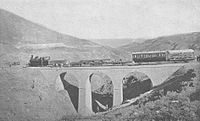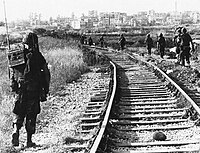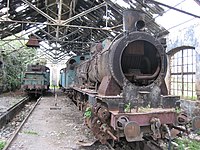Rail transport in Lebanon

Rail transport in Lebanon began in the 1890s as French projects under the Ottoman Empire but largely ceased in the 1970s owing to the country's civil war. The last remaining routes ended for economic reasons in the 1990s. At its peak Lebanon had about 408 kilometres (254 mi) of railway.[1]
History
Ottoman Empire





Hasan Beyhum Efendi received a concession to construct a tramway between Beirut and Damascus in 1891.[5] Beyhum sold the concession later that year to the French Beirut–Damascus Tramway (French: Compagnie de la voie ferrée économique de Beyrouth–Damas)[5][6] or Lebanon Railway, which was anxious to forestall two mooted British lines, one from Jaffa[7] and another from Haifa,[6][2][n 1] either of which would have undercut Beirut's status as the primary port of the northern Levant.[2] In the event, the Jaffa line was never extended towards Damascus and the Haifa line ran out of money having completed just 8 km (5.0 mi)[8] or 21 mi (34 km)[6] of track.
Around the same time, the French Damascus Tramways (Compagnie des tramways de Damas et voies ferrées économiques de Syrie).
The two lines quickly merged as the Société des Chemins de fer Ottomans économiques de Beyrouth–Damas–Hauran
In 1893, the company received a concession for a line from Damascus to
Wheat from the
The line suffered a serious accident at Aley on 12 April 1904. Aley had grown with the railroad and functioned as a summer resort for the people of Beirut. Part of the locomotive exploded on the 7% incline east of town and, not thinking to apply the brakes, the train was allowed to fly back through the station. Two cars were completely destroyed upon the rocks on the other side, killing 8 and seriously injuring 21.[16]
The Aleppo Railway
The concession for the
A separate 1,050 mm (3 ft 5+11⁄32 in)-gauge coastal railway, the Lebanese Tramway (Tramway Libanais) began service in 1895 and reached
During the
French Mandate

Following the
From around 1930, the Aleppo Railway formed a stage on the
Independent Lebanon


General
Syria
Only a very short length of the
Background on trains from Istanbul to Syria: A brief history of the Taurus Express
Agatha Christie wrote the first part of her novel Murder on the Orient Express during her stay in room 203 in Baron Hotel in Aleppo.[22] The novel doesn't start in Istanbul, or on the Orient Express. It opens on the platform at Aleppo, next to the two blue-and-gold Wagons-Lits sleeping cars of the Taurus Express bound for Istanbul. The Taurus Express was inaugurated in February 1930 by the Compagnie Internationale des Wagons-Lits, the same company that operated the Orient Express and Simplon Orient Express, as a means of extending their services beyond Istanbul to the East. It ran several times a week from Istanbul Haydarpaşa station to Aleppo and Baghdad, with a weekly through sleeper to Tripoli in Lebanon. After the second world war, the Wagons-Lits company gradually withdrew and operation of the Taurus Express was taken over by the Turkish, Syrian and Iraqi state railways. Up until the late 1980s, a twice-weekly Istanbul-Baghdad service was maintained, with weekly through seating cars from Istanbul to Aleppo. For political reasons, the through service to Baghdad was suspended and the main train curtailed at Gaziantep, but the weekly through seat cars Istanbul-Aleppo were maintained. In 2001, the Aleppo portion of the Toros Express was speeded-up and given a proper Syrian sleeping-car instead of the two very basic Turkish seat cars. You could once again travel in the security and comfort of a proper sleeper from Istanbul to Syria, and it was a great way to go.[23]
Trains functioning in Syria:
- LDE DE (Diesel-electric)
- DMU-5 DH (Diesel-hydraulic): Multiple units from Hyundai Rotem, Korea for Aleppo-Damascus/Latakia long-distance services. 222-second class, 61 first class.
Networks:
- Damascus - Homs - Hamah - Aleppo - Maydan Ikbis (- Ankara, Istanbul, Turkey TCDD)
- Aleppo (- Gaziantep, Turkey TCDD)
- Aleppo - Latakia - Tartus - Al Akkari - Homs
- Homs - Palmyra: freight only, opened for phosphates traffic, destined for the port of Tartus, in 1980
- Line runs from the oilfields of Al Qamishli in the north to the port of Latakia(750 km)
- Al Akkari (- Tripoli CEL, out of use)
- Aleppo - Deir ez-Zor - Al-Qamishli (- Nusaybin, Turkey TCDD)
- Extension from Homs southwards to Damascus (194 km) was opened in 1983
- 80 km (50 mi) Tartus-Latakia line in 1992
- Al Qamishli - Al-Yaarubiyah (- IRR Iraq, out of use)
- Damascus - Sheikh Miskin - Dera'a: under construction, to replace a section of Hejaz railway
- Sheikh Miskin - Suwayda (under construction)
- Palmyra - Deir ez-Zor - Abu Kemal (- IRR Iraq) (planned)
Israel
Israel's national railway operator,
Trains functioning in Israel:
- Siemens Desiro HC (Electric)
- Siemens Viaggio Light (Diesel-electric)
- Bombardier Double-Deck Coach (Electric and Diesel-electric)
Networks:
- Beersheba - Kiryat Gat - Ramla - Lod - Tel Aviv - Herzliya - Haifa - Nahariya
- Beersheba - Kiryat Gat - Ramla - Lod - Tel Aviv - Herzliya - Hadera - Haifa - Karmiel
- Modi'in - Ben Gurion Airport - Tel Aviv - Binyamina - Haifa - Nahariya
- Jerusalem - Ben Gurion Airport - Tel Aviv - Herzliya
- Atlit - Haifa - Afula - Beit She'an
- Beersheba - Netivot - Ashkelon - Lod - Tel Aviv - Herzliya - Netanya - Hadera - Binyamina
- Ashkelon - Rishon LeZiyyon - Tel Aviv - Rosh Ha'Ayin - Kfar Saba - Herzliya
- Beit Shemesh - Ramla - Lod - Tel Aviv - Herzliya - Netanya
- Beersheba - Dimona
- Beersheba - Ramat Hovev (freight only)
- Beersheba - Dimona - Rotem (freight only)
- Hadera - Kfar Saba - Rosh Ha'Ayin - Lod (under construction)
- Rishon LeZiyyon - Modi'in (under construction)
Rolling stock
Retired
| Class | Image | Axle Formula | Number | Year in Service | Power [kW] |
Constructor | Notes |
|---|---|---|---|---|---|---|---|
| Uerdingen railbus | 
|
12 | Former German railbuses, in 1982–83 acquired from DB via MAS. Last one delivered in 1986–87. Apparently all destroyed during Lebanese Civil War. 798 672-2 > A 10450 |
Planned revival


There have been a number of proposals for reviving the Lebanese railway system, but as yet, none have come to fruition.
According to a study funded by the
In 2011, Dr. Maroun Kassab, an architect and assistant professor, proposed a coastal metro system that can capitalize on the existing lands owned by the ministry and that can run underground from Tyr to Tripoli.[30]
In February 2022 media reported a proposed Spanish grant for the reestablishment of Lebanese railways.[31]
See also
- Syrian railways
- Transport in Syria
- Arab Mashreq International Railway
- Palestine Railways
- Tripoli Railway Station
- OCFTC, Lebanon's public transport operator
- AS DPHB, the defunct football club of the Lebanese railways
Notes
- Syria Ottoman Railway Company, which lost its 1890 concession a year later after having failed to construct any track and ultimately was nationalized by the Ottomans in 1900 along with the British Haifa–Darʾa Railway after both ran into financial difficulties after only completing 8 km (5.0 mi) of track each.[8]
- Hejaz Railway was also an Ottoman response to a local uprising: in its case, the Hauran Uprising of 1898.[4]
References
Citations
- ^ a b c d "Syria's destruction revives a dream of rebuilding Lebanon's railway". The Economist. 5 October 2017.
- ^ a b c d e Burns (2005), p. 257.
- ^ a b c Freeman, Lewis R. (1915), "The Railway Lines of Syria and Palestine: Resumé of Conditions before the War; Well Managed Lines of Syria Compared with Run-down Hedjaz Railway", Railway Age Gazette, vol. 59, Simmons–Boardman Publishing Co., pp. 199ff
- ^ a b c Schilcher (1998), p. 104.
- ^ a b c d e f g Bilmez (2008), p. 195.
- ^ a b c d Anderson & al. (1918), p. 208.
- ^ a b c "Un bref aperçu de l'histoire des chemins de fer au Liban [A Brief History of Railways in Lebanon]", Section Libanaise de l'Association Française des Amis des Chemins de fer [Lebanese Section of the French Railway Friends Association], retrieved 24 August 2008. (in French)
- ^ a b c d Bilmez (2008), p. 196.
- ^ a b c d e f g Ludvigsen, Børre (2008), "CEL: Chemin de Fer de l'Etate Libanais: The Lebanese State Railway Company", Al Mashriq: The Levant, Halden: Østfold University, retrieved 16 September 2015.
- ^ a b c d e Knowles, J.W. (June 1974), "The Beirut Damascus Railway", Continental Railway Journal, vol. No. 18, pp. 117–123
{{citation}}:|volume=has extra text (help). - ^ a b c d e Schilcher (1998), p. 97.
- ^ a b c d e f g h i j k l m n Ludvigsen, Børre (2008), "Background", Al Mashriq: The Levant, Halden: Østfold University, retrieved 16 September 2015.
- ^ Burns (2005), p. 258.
- ^ a b c d Schilcher (1998), p. 100.
- ^ a b c Schilcher (1998), p. 105.
- ^ "Unfall auf der Hauranbahn [Accident on the Hauran Road]", Die Lokomotive: Illustrierte Fachzeitung, Vienna: Kaiserlich-Königliche Hofbibliothek, May 1904, p. 49. (in German)
- ^ a b Reports and Papers, vol. Vol. CXVI, London: House of Commons, 1908, p. 810
{{citation}}: External link in|volume= - ^ a b Ludvigsen, Børre (2008), "Riyaq–Homs", Al Mashriq: The Levant, Halden: Østfold University, retrieved 16 September 2015.
- ^ Burns (2005), p. 259.
- ^ Schilcher (1998), p. 98.
- ^ Australian Railway Construction in the Middle East Knowles, J.W. Australian Railway Historical Society Bulletin, November, 1978 pp. 244–259
- )
- ^ "How to travel by train from London to Syria | Train travel in Syria".
- ^ "Error" (PDF).
- ^ "Error" (PDF).
- ^ HaRakevet: Rothschild PhD, Rabbi Walter (March 1991), Schienenbusse for Lebanon. Issue 12
- ^ Section Libanaise de l’Association Française des Amis des Chemins de fer. Actualité Archived 24 July 2011 at the Wayback Machine. Retrieved 24 August 2008.
- ^ Lebanese railway revival to be studied [1]. Retrieved 23 August 2013.
- ^ Van Tets, Fernande (19 October 2014). "All aboard the Lebanon express: Nostalgia and a desperate need could revive Arab world's first railway". The Independent. Retrieved 6 April 2015.
- ^ Kassab, Maroun. "PROPOSAL FOR A LEBANESE COASTAL METRO SYSTEM".
- ^ "Lebanon to get Spanish funds for railway revival plan: minister - Al-Monitor: The Pulse of the Middle East". www.al-monitor.com. Retrieved 19 March 2022.
Bibliography
- Anderson, Frank Maloy; et al. (1918), "Railway Concessions in Turkey", Handbook for the Diplomatic History of Europe, Asia, and Africa 1870–1914, Washington: GPOfor the National Board for Historical Service, pp. 205–211.
- Bilmez, Bülent (2008), "European Investments in the Ottoman Railways, 1850–1914", Across the Borders: Financing the World's Railways in the Nineteenth and Twentieth Centuries, Aldershot: MPG Books for Ashgate Publishing, pp. 183–206, ISBN 978-0-7546-6029-3.
- Burns, Ross (2005), Damascus: A History, Abingdon: Routledge, ISBN 978-0-415-41317-6.
- Schilcher, Linda S. (1998), "Railways in the Political Economy of Southern Syria 1890–1925", The Syrian Land: Processes of Integration and Fragmentation: Bilād al-Shām from the 18th to the 20th Century, Berliner Islamstudien [Islamic Studies in Berlin], Vol. 6, Stuttgart: Franz Steiner Verlag, pp. 97–112, ISBN 3-515-07309-4.
